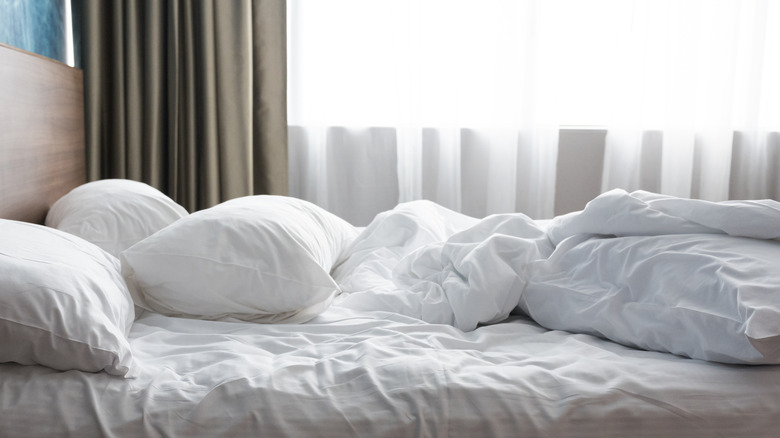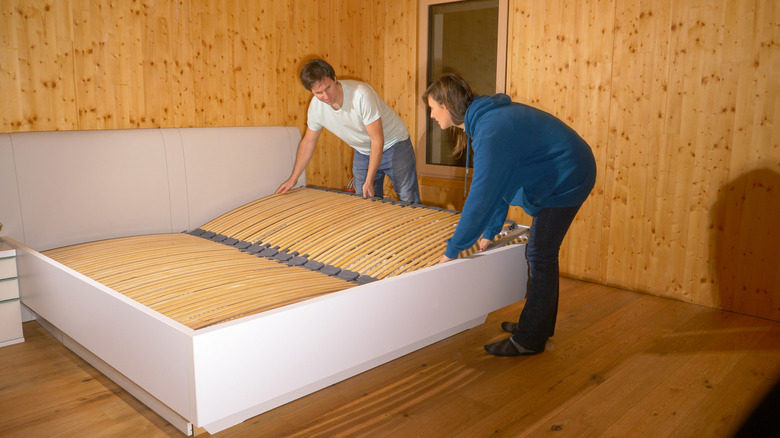The Quickest Way To Fix A Sagging Mattress Uses Something You Already Have
A sagging mattress can cause you to feel pretty sad when you get out of the sack. The lack of support while you slumber often contributes to uncomfortable aches and pains and to poor or disrupted sleep, whether from general discomfort or from overheating as you've sunk into a spot where the mattress reduces air circulation. One quick and easy fix for this issue relies on something else you'll find in the bedroom: one or more pillows, properly placed.
Putting a pillow between the mattress and your bed frame or box spring can redistribute the pressure on your mattress and potentially smooth out those sags. To get the best effect, you may need to add additional pillows, rearrange them into specific spots to best address the sags in your mattress, or even add some blankets to the mix. Keep in mind that it can take a while for your mattress to return to its original shape. Some mattress retailers regard this pillow placement as a short-term, stopgap solution, while other sleep experts caution that putting pillows underneath the mattress could actually speed up the rate at which the mattress wears out, due to the unevenness of support. Putting your pillows to use atop the mattress, however, is seen as safe. For sagging along the edge, you can add a body pillow in that area. Or, for additional support in sagging areas, you can sleep with firm extra pillows beneath your back, legs, or hips.
Other ways to fix a sagging mattress
Switching up the spots where you're regularly putting pressure on a mattress is another way to even out sagging over time. Rotating your mattress 180 degrees, so the head becomes the foot and vice versa, causes your body weight to rest on different areas. For most mattresses, you should do this every three to six months. Flipping the mattress, so the bottom becomes the top, is a different story. Many modern mattresses are built in layers and not designed to be flipped. Check your manufacturer's instructions.
You can also support your sagging mattress by placing a thin sheet of plywood beneath it, between the mattress and the bed frame or box spring. Depending on the size of your mattress, you may need more than one piece. Or you could buy or DIY a bunkie board, a piece of wood that functions like a thin box spring and supports your entire mattress. Additional methods for fixing your mattress's sagging from beneath the bed include adding a center support leg to the middle of your bed frame, or adjusting uneven legs which mean your bed isn't level.
Purchasing a mattress topper is another option. While it doesn't actually fix the sag, this extra layer sits on top of your existing mattress and provides a smooth surface for you to sleep on. You might consider buying an egg crate mattress topper or one of the many other options made from a variety of materials and available in thicknesses generally ranging from two to five inches.
How to prevent a mattress from sagging
Eventually, of course, you'll recognize the signs that your mattress is too old. You might, for instance, measure sag of more than 1-½ inches when you perform the string test, which consists of laying a string taut across your mattress, then measuring the distance between it and the bottom of any sags you see. A timing test checks if the dent your body has left springs back within one minute of arising. Test failures can indicate that it's time to shop for a mattress online or in-store.
With that new purchase, you'll want to stop sags before they start. If advised by the manufacturer, regular rotation or flipping the mattress can play a part in that, as can fixing up your bed's foundation by making sure the bed frame is in good repair and is the correct size for your mattress, including that any supportive slats are the minimum distance apart your mattress manufacturer recommends. You can also use a mattress protector, a mattress topper, or both, to help in keeping your mattress clean and distributing your weight more evenly. You can also address weight distribution by mixing things up in the bedroom: If you sleep alone, try positioning yourself on opposite sides of the bed, or in the center, on different nights. If you share bed space, switch sides occasionally. Don't sit on the edge of the bed for long periods of time and, of course, when it comes to weight distribution and preventing sags, no more monkeys — or anyone – jumping on the bed.


